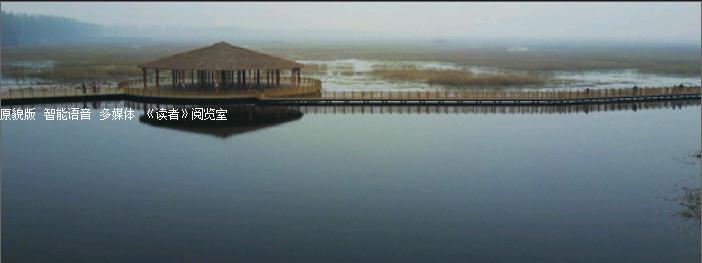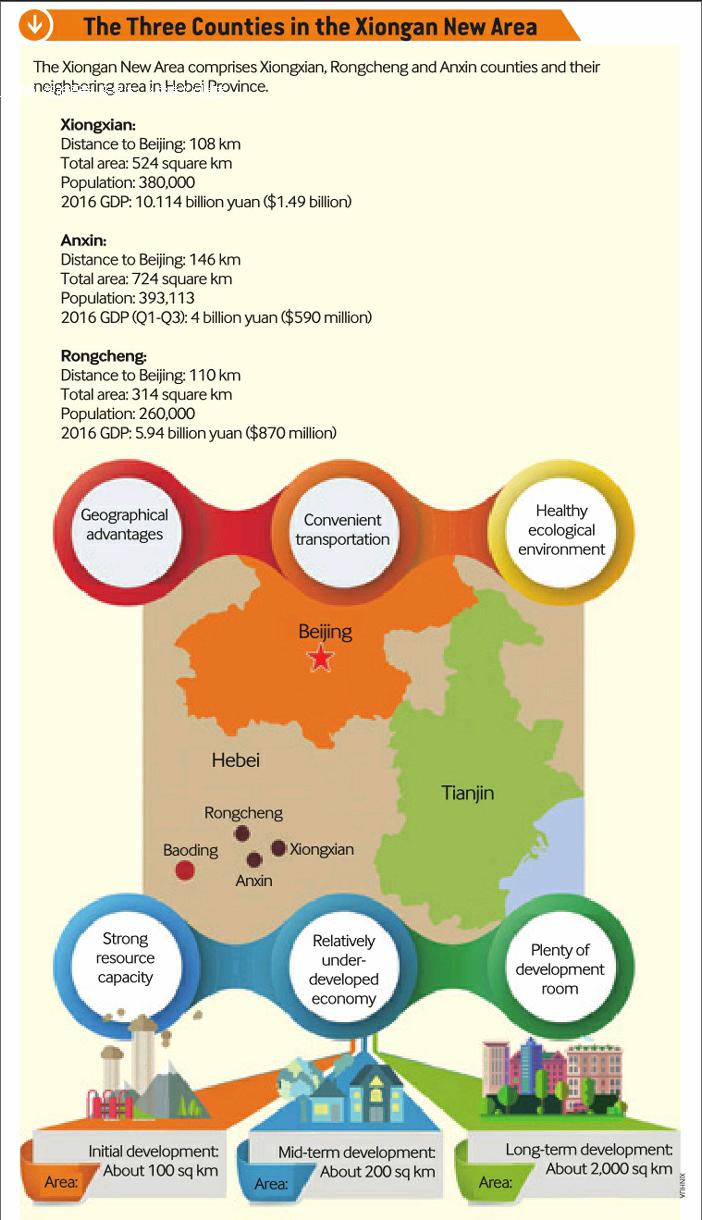BRAND NEW START
2017-05-02ByYuanYuan
By+Yuan+Yuan


Three small counties resting in the middle of north Chinas Hebei Province had stayed silent for years until breaking news brought them all the way to the front stage to sparkle in the spotlight.
The news, released on April 1 by News Broadcast, the most important daily news program on China Central Television, is not an April Fools joke. The three places, Xiongxian, Anxin and Rongcheng, under the jurisdiction of Baoding, Hebei Province, will form a new development zone, the Xiongan New Area, to parallel the Shenzhen Special Economic Zone and the Shanghai Pudong New Area, Chinas successful test beds for reform and opening up.
Compared with the Shenzhen Special Economic Zone, which covers 1,991 square km, and the Shanghai Pudong New Area, which covers 1,210 square km, the new area will initially occupy 100 square km and eventually 2,000 square km.
Why there?
Located about 100 km southwest of downtown Beijing, the new area had hardly registered on Chinas economic map before. Even many people from the same province had never heard of the three counties before the news.
It is reported that the three counties had a combined GDP of about 20 billion yuan ($2.94 billion) last year, less than 1 percent of Beijings economic output.
Xiongxian, with various plastic factories and companies, is a center of plastics manufacturing. Even though it was a military stronghold in historical times, this location had hardly been connected to anything important for quite a while.
The decision to establish the new area is part of a greater strategy, which China initiated in 2014, to jointly develop Beijing, the port city of Tianjin and Hebei Province to improve the regions economic structure, environment and public services, and bridge the gap between the capital and the industrial and rural areas surrounding it.
The distance of the new area from both Beijing and Tianjin, the two major municipalities in north China, is about 100 km, the same as that from Beijing to Tianjin, which makes the interconnected area resemble an equilateral triangle.
“The site of the new area was carefully chosen,” said He Lifeng, Minister of the National Development and Reform Commission (NDRC), during an interview with Xinhua News Agency on April 5. “The choice is based on practicality after rounds of comparison and rigorous research by experts. The new area is part of measures to advance the coordinated development of the BeijingTianjin-Hebei region.”
The transportation connections of the new area, according to He, will be very convenient, with Beijing, Tianjin and Shijiazhuang, capital city of Hebei, all within a half-hours commute.
The Baiyangdian Lake, the largest freshwater lake in north China, is located in the zone, which will make the zone ecologically healthy with a relatively strong environmental capacity. The relatively less-developed economy in the region also offers developers plenty of room.
Beijing now is home to over 21 million people, and the number is expected to reach 23 million in 2020. Traffic congestion, soaring property prices and excessive burdens on resources are all severe “urban ills” of the huge capital. The root of these issues lies in the capital taking on too many “non-capital functions,” and Beijing has long been considering curbing population growth and relocating industries and other noncapital functions to Hebei in the coming years, said the NDRC head.
“Previous administrations have struggled trying to balance Beijings burden of doubling as a metropolis and a political center,”Nie Huihua, a professor of economics at Renmin University of China, told Caixin, Chinas leading financial and investigative news organization. “Now the picture is becoming clearer: Many of its metropolitan functions will be transferred to Tongzhou District, in what used to be Beijings suburban east, and the Xiongan New Area will shoulder part of Beijings non-capital functions, such as the development of hi-tech industries. Tongzhou and Xiongan are now like Beijings two wings.”
Beijing will focus on its “capital functions,”which means serving as the countrys political center, cultural center, and center for international exchanges and science and technological innovation.
Another major task of the Xiongan New Area, Nie said, is to promote Hebeis economic and social development and help develop the Beijing-Tianjin-Hebei region into a world-class metropolitan area. “The area will boost the economy in the region surrounding the capital, where Beijings wealth and prominence have not spread,” Nie said.
Clearly, Chinas authorities envisage Xiongan as a driver of economic growth in the BeijingTianjin-Hebei region. Xinhua emphasized the status of Xiongan as “a national-level new area after the Shenzhen Special Economic Zone and the Shanghai Pudong New Area.” Its two predecessors respectively supported the growth of the Pearl River Delta in the south and the Yangtze River Delta in the east.
Compared to the Shenzhen Special Economic Zone and Pudong New Area, the Xiongan New Area was born with a silver spoon in its mouth. Xinhua stressed the development of Xiongan as the countrys “big millennial plan,” a term that has rarely been used before, which shows both the strategic significance of this project and the difficulty of assessing its success in the short term.
All the changes
To prevent speculation on property in the new area, all real estate sales in the new area have been suspended. The preparatory committee for the Xiongan New Area said it will continue to address inconsistencies in the trade and construction of houses and will work toward achieving a stable real estate market in the new area.
This was just the beginning of the transformation of this area. A 32-year-old man, under the pseudonym Chen Bo, told The Beijing News on April 1 that he immediately decided to leave Beijing, where he has been working for eight years, and go back home in Xiongxian for his future career.
Chen also found that dozens of locals from Xiongxian working in Beijing had made the same decision and couldnt wait to get back.
A 23-year-old Anxin local surnamed Lu still couldnt believe the news when he talked to Beijing Review on April 4. “It is like a dream,” Lu said. “I came back to work in this county last year after I graduated from college, and I always complained how boring life is in this town. But now, it is like a big surprise, and Im looking forward to the huge changes that will come in the following years.”
Some locals, though, are keeping a cool head amidst the excitement. A 43-year-old Xiongxian local surnamed Liu expressed concern about his job at a plastics manufacturer.
“Im almost 100 percent sure that the plastics business will not be allowed in the future due to the pollution problem,” Liu said. “I have to find a new job. Im considering opening a small restaurant.”
This is the concern shared by many people in Xiongxian, as plastics manufacturing is an economic mainstay of the area.
“I can say that every household has a connection to the plastics business,” said Li Xiaodou, Director of Hebei Packaging Association, during an interview with The Economic Observer. “Even though the new area plan will no doubt bring new opportunities for local development, the pollution caused by plastics enterprises cannot be solved within a short period.”
“I think the government will definitely call a stop to plastics production,” Li Gensheng, the owner of Huatao Plastic Factory in Xiongxian, said.
Li said these days, the government has been demanding that they stop production on smoggy days, and business is getting harder to do. “By then, I will sell the machines and switch to other businesses,” Li said.
New way ahead
On April 1, the Central Government appointed Xu Qin, former Shenzhen Mayor and Secretary of the Communist Party of China (CPC) Shenzhen Municipal Committee, to become deputy secretary of the CPC Hebei Provincial Committee. Many people expect him to make use of his nine years of experience in Shenzhen to aid the development of Xiongan.
However, Xiongan will not be able to compare economically with Pudong or Shenzhen in the near future, said He Lifeng, Minister of the NDRC, on April 5.
Shenzhen took off on the back of neighboring Hong Kong. Pudong relied on Shanghais role as an international fi nancial and trade center. Both the Pearl River Delta and the Yangtze River Delta were natural hot spots that were already home to manufacturers and big businesses. Xiongan and its neighboring areas in Hebei have no similar economic might. Instead, Xiongan may prove to be a place where the Central Government can focus on its experiments with urbanization, supply-side reform and even governance models.
Xiongan will be an answer to Chinas growth conundrum: Breakneck urban sprawl must give way to a strategy of balanced and inclusive development.
Protecting the local ecology will be a priority, as the authorities do not want to repeat the outdated practice of “pollution fi rst, treatment later.” People will live in a cleaner and safer environment.
Master and detailed blueprints of the new area and a plan on the ecological conservation of the Baiyangdian region are among the first plans to be mapped out, He told Xinhua.
The NDRC chief pointed to reform as a key to development, saying that new administrative, investment and fi nancing models will be tried in the new area.
Innovation will be the fundamental driver in building and developing the Xiongan New Area, and policies will be put in place to bring innovative elements to the area, said He.
Xu Kuangdi, head of the expert advisory committee on the collaborative development of Beijing, Tianjin and Hebei, suggested that the construction of the Xiongan New Area should focus on technological and innovative industries and the region should attract high-end innovative talent and resources.
He emphasized the point by saying that the new area will create a favorable environment for innovation and attract innovative talent and teams to help build it into a “high ground” for innovation and a new science and technology city.
“Apart from having world-class urban planning, the architecture in the new area will also showcase Chinese cultural characteristics,” He said.
The new area together with Zhangjiakou—where the 2022 Winter Olympics will be held—are expected to become two driving forces for Hebeis development, He said.
